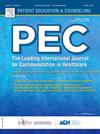在医疗咨询中推荐手术或非手术治疗:在中国语境下的案例。
IF 2.9
2区 医学
Q2 PUBLIC, ENVIRONMENTAL & OCCUPATIONAL HEALTH
引用次数: 0
摘要
目的:本研究探讨了中国外科和非手术治疗建议的设计和实施。方法:我们使用会话分析检查了936分钟的医疗咨询录音。数据来自中国的两家三级医院。他们是来自骨科和肛肠科的真实互动。结果:诊断后提出非手术治疗建议。它们以直接和简单的形式交付,并且已经确定。外科治疗建议被早期提出,有时占据诊断的位置。它们以直接、简单、但缓和的形式传递。这些建议是作为一个尚未完全解决的问题拟订的,需要进一步讨论。结论:患者对特定治疗的立场体现在医生建议的剪裁上。治疗建议的配方显示了医生对患者预期或抵制的理解。中国患者对非手术治疗的偏好,体现在医生对手术和非手术治疗的建议上。实践意义:患者的担忧取决于所推荐的治疗方法。医生应该把这些问题纳入他们的医疗建议。在中国,对于非手术患者,重点是清楚地解释治疗方案。对于手术患者,医生应首先帮助他们做出明智的治疗决定。本文章由计算机程序翻译,如有差异,请以英文原文为准。
Recommending surgical or non-surgical treatments in medical consultations: The case in Chinese contexts
Objectives
This study examines the design and delivery of surgical and non-surgical treatment recommendations in China.
Methods
We examined 936-minute recordings of medical consultations using conversation analysis. Data were collected from two tertiary hospitals in China. They are authentic interactions from the departments of orthopedics and proctology.
Results
Non-surgical treatment recommendations are proposed after diagnoses delivery. They are delivered in straightforward and simple form, and as already determined. Surgical treatment recommendations are proposed early and sometimes occupy the diagnostic slot. They are delivered in straightforward, simple, but mitigated form. These recommendations are formulated as a matter that is not fully settled and requires further discussions.
Conclusions
Patients’ stances toward specific treatments are made manifest in the tailoring of doctors’ recommendations. The formulations of treatment recommendations exhibit doctors’ understanding of what patients are anticipating or resisting. Chinese patients’ preference for non-surgical treatments over surgery is reflected in how doctors present the recommendations for surgical and non-surgical treatments.
Practice implications
Patients’ concerns vary depending on the treatments recommended. Doctors should incorporate these concerns into their medical advice. In China, for non-surgical patients, the focus is on clearly explaining the treatment plan. For surgical patients, doctors should first assist them in making informed treatment decisions.
求助全文
通过发布文献求助,成功后即可免费获取论文全文。
去求助
来源期刊

Patient Education and Counseling
医学-公共卫生、环境卫生与职业卫生
CiteScore
5.60
自引率
11.40%
发文量
384
审稿时长
46 days
期刊介绍:
Patient Education and Counseling is an interdisciplinary, international journal for patient education and health promotion researchers, managers and clinicians. The journal seeks to explore and elucidate the educational, counseling and communication models in health care. Its aim is to provide a forum for fundamental as well as applied research, and to promote the study of organizational issues involved with the delivery of patient education, counseling, health promotion services and training models in improving communication between providers and patients.
 求助内容:
求助内容: 应助结果提醒方式:
应助结果提醒方式:


